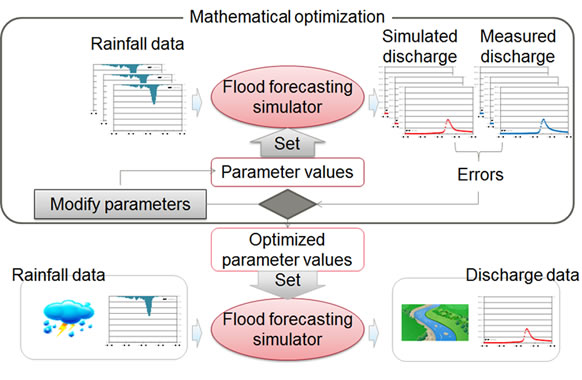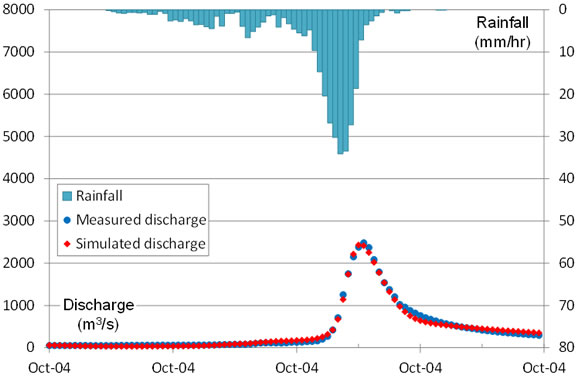Archived content
NOTE: this is an archived page and the content is likely to be out of date.
PWRI and Fujitsu Develop Technology that Automatically Adjusts Parameters of Flood Forecasting Simulators
Public Works Research Institute,Fujitsu Laboratories Ltd.
-
[1] Research on the deployment of mathematical optimization methods in flood forecasting models
Joint research for which PWRI publicly solicited partners, and for which Fujitsu Laboratories applied and was accepted. PWRI provided the flood forecasting simulation technology, as well as a simulator and data, and Fujitsu Laboratories provided mathematical optimization technology.
-
[2] Nash-Sutcliffe model efficiency coefficient
A coefficient that assesses how well calculated values from a simulation model match observed measurements.
Nash-Sutcliffe efficiency coefficient = 1 - (residual variance between predicted and observed values) / variance distribution of observed values -
[3] Integrated Flood Analysis System (IFAS)
An integrated analysis system for flood forecasting simulations developed and publicly released by PWRI: http://www.icharm.pwri.go.jp/research/ifas/
About Public Works Research Institute
Public Works Research Institute accurately identifies social requirements, the people's needs and international needs and, by producing quality research results, aims to return benefits of its research results to society. In order to attain those achievements, the research departments of four institutions, Tsukuba Central Research Institute, Civil Engineering Research Institute for Cold Region, International Center for Water Hazard and Risk Management and Center for Advanced Engineering Structural Assessment and Research, implement research on prevention and reduction of natural disasters, improvement of living environment, advanced social capital stock management, measures regarding global environment issues such as energy/ resource saving, development of social capital suitable for the snow piling cold climate, advanced research and development such as new materials/ new construction methods for development of Hokkaido's agricultural and fisheries foundation and research and development in basic areas such as phenomenon/ mechanism analysis and general technologies that forms the foundation of the entire public works technologies.
About Fujitsu
Fujitsu is the leading Japanese information and communication technology (ICT) company offering a full range of technology products, solutions and services. Approximately 162,000 Fujitsu people support customers in more than 100 countries. We use our experience and the power of ICT to shape the future of society with our customers. Fujitsu Limited (TSE: 6702) reported consolidated revenues of 4.8 trillion yen (US$46 billion) for the fiscal year ended March 31, 2014. For more information, please see http://www.fujitsu.com.
About Fujitsu Laboratories
Founded in 1968 as a wholly owned subsidiary of Fujitsu Limited, Fujitsu Laboratories Ltd. is one of the premier research centers in the world. With a global network of laboratories in Japan, China, the United States and Europe, the organization conducts a wide range of basic and applied research in the areas of Next-generation Services, Computer Servers, Networks, Electronic Devices and Advanced Materials. For more information, please see: http://www.fujitsu.com/jp/group/labs/en/.
Press Contacts
General Affairs Division
![]() E-mail: soumu@pwri.go.jp
E-mail: soumu@pwri.go.jp
Company:Public Works Research Institute
Technical Contacts
International Centre for Water Hazard Risk Management (ICHARM)
![]() E-mail: suimon@pwri.go.jp
E-mail: suimon@pwri.go.jp
Company:Public Works Research Institute
Technical Contacts
Social Innovation Laboratories
Knowledge Platforms Lab.
![]() E-mail: flood@ml.labs.fujitsu.com
E-mail: flood@ml.labs.fujitsu.com
Company:Fujitsu Laboratories Ltd.
All company or product names mentioned herein are trademarks or registered trademarks of their respective owners. Information provided in this press release is accurate at time of publication and is subject to change without advance notice.
Date: 09 March, 2015
City: Tsukuba and Kawasaki, Japan
Company:
Public Works Research Institute / Fujitsu Laboratories Ltd.

